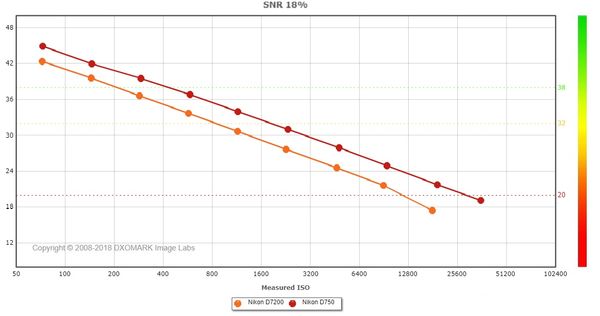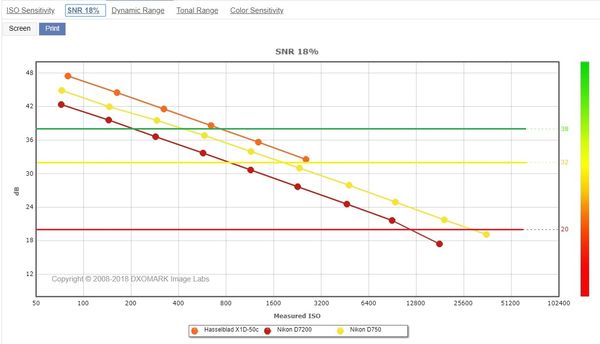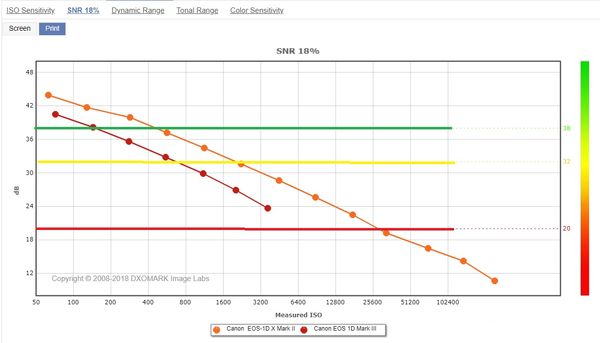The Onset of Noise, and its relationship to high-density high-megapixel sensors
Mar 15, 2019 20:11:22 #
RichardTaylor wrote:
This statement not entirely correct.
Fans in PCs are used to keep the temperature down so the electronic components will not overheat and stop working or to fail prematurely..
Fans in PCs are used to keep the temperature down so the electronic components will not overheat and stop working or to fail prematurely..
You're right, Richard - I had "noise" on the brain, when I wrote that. Of course - it should've been "heat."
Mar 15, 2019 20:26:14 #
You can see the difference in signal to noise ratio in DxO labs testing. I loaded the Nikon D750 (5.97 micron pixels), and the Nikon D7200 (3.92 micron pixels) into their sensor comparison tool. Full frame cameras always have a higher signal to noise ratio.
Mar 15, 2019 20:54:07 #
Strodav
Loc: Houston, Tx
The paradigm of sensor pixel size (pixel density) holds true in general, but there are significant variations sensor to sensor and manufacturer to manufacturer so I rely on SNR measurements from a reputable testing organization like DxOMark.com to show me how well a sensor and camera perform. Some manufacturers seem to be able to build better sensors and use them more effectively than other manufacturers.
Mar 16, 2019 02:46:43 #
From personal experience and use (always shooting raw).
From worst to best.
C2005 Canon 350D 22.2x14.8mm sensor size - 8MP (**)
C2009 Canon G11 P&S - 10MP (not a huge ammount of difference between these two. (**)
C2007 Canon 40D 22.2x14.8mm sensor size - 10.1MP
C2005 Canon 5D 35.8x23.9mm sensor size - 12.8mp - Full frame and a big step up image wise from the above cameras.
C2015 Olympus OM-D E-M5 II 17.3 x 13 mm (M4/3) - 16MP
C2013 Canon 70D 22.5 x 15mm (APS-C) - 20MP (I feel it is about 1 stop better in noise performance than the Olympus body above), however there are other factors that increase usability, in the real world, for a lot of my shooting needs (not all) - by using the Olympus bodies.
As the above shows a smaller MP camera is not necessarily better noise wise than a larger sensor camera (from using my own cameras).
(see my first post in this thread)
From worst to best.
C2005 Canon 350D 22.2x14.8mm sensor size - 8MP (**)
C2009 Canon G11 P&S - 10MP (not a huge ammount of difference between these two. (**)
C2007 Canon 40D 22.2x14.8mm sensor size - 10.1MP
C2005 Canon 5D 35.8x23.9mm sensor size - 12.8mp - Full frame and a big step up image wise from the above cameras.
C2015 Olympus OM-D E-M5 II 17.3 x 13 mm (M4/3) - 16MP
C2013 Canon 70D 22.5 x 15mm (APS-C) - 20MP (I feel it is about 1 stop better in noise performance than the Olympus body above), however there are other factors that increase usability, in the real world, for a lot of my shooting needs (not all) - by using the Olympus bodies.
As the above shows a smaller MP camera is not necessarily better noise wise than a larger sensor camera (from using my own cameras).
(see my first post in this thread)
Mar 16, 2019 05:40:20 #
CO wrote:
You can see the difference in signal to noise ratio in DxO labs testing. I loaded the Nikon D750 (5.97 micron pixels), and the Nikon D7200 (3.92 micron pixels) into their sensor comparison tool. Full frame cameras always have a higher signal to noise ratio.
Thanks, CO … you know, even with the assumed difference, from one being FF and the other being DX - there does not seem to be a GREAT deal of difference, between the two, overall - does there, CO?
Mar 16, 2019 05:47:30 #
RichardTaylor wrote:
From personal experience and use (always shooting ... (show quote)
Very interesting, there, Richard … so, overall - you feel the 70D is best on noise performance. Too bad, you don't have any 24MP bodies, there, as I'd like to see how you think they compare w/ the others ….
Mar 16, 2019 05:53:44 #
Chris T wrote:
Very interesting, there, Richard … so, overall - you feel the 70D is best on noise performance. Too bad, you don't have any 24MP bodies, there, as I'd like to see how you think they compare w/ the others ….
Only for the digital cameras I have owned.
It's not what I feel it's what I know from shooting in the real world.
If you never shoot at high - to very high ISO values it may not really matter, and I am not a camera collector.
Mar 16, 2019 06:47:47 #
steve49
Loc: massachusetts
In any tech related product I think newer will generally be better.
A lot newer will be a lot better....
Maybe not in airplanes though.
A lot newer will be a lot better....
Maybe not in airplanes though.
Mar 16, 2019 07:30:15 #
My Canon 1D MkIII is 10mp and several generations older than my 1Dx MkII which is twice the megapixels. But while both are low noise leaders in their generation/build era there is no comparison between the two. The MkII is vastly more capable of high ISO shooting than the MkIII. I would say the MkIII is good to ISO 800 or perhaps 1,600 while the MkII is easily capable of ISO 25,000.
Technology marches forward. It is best to compare cameras of the same era and generation in my view. Also note that the MkII is full frame sensor and the MkIII is an APS-H sensor, 1.3x crop factor. The 1Ds was the same era as the MkIII but probably had slightly better ISO performance. I have not owned one nor compared the specs, but the MkIII was built for speed and the 1Ds not as much. They merged into one 1 series body with the 1Dx I believe.
Technology marches forward. It is best to compare cameras of the same era and generation in my view. Also note that the MkII is full frame sensor and the MkIII is an APS-H sensor, 1.3x crop factor. The 1Ds was the same era as the MkIII but probably had slightly better ISO performance. I have not owned one nor compared the specs, but the MkIII was built for speed and the 1Ds not as much. They merged into one 1 series body with the 1Dx I believe.
Chris T wrote:
I tend to think my lowly 12MP Canon EOS Rebel T3 d... (show quote)
Mar 16, 2019 07:35:57 #
Chris T wrote:
Thanks, CO … you know, even with the assumed difference, from one being FF and the other being DX - there does not seem to be a GREAT deal of difference, between the two, overall - does there, CO?
There does seem to be a significant difference. I added the medium format Hasselblad X1D-50c to the comparison. This is from their explanation about the noise:
DxOMark has three dotted lines on the graph, a green line, a yellow line, and a red line. Above the green line, photos taken at those ISOs will be relatively free of noise. Under the green line noise will be noticeable. Under the yellow line noise will be quite noticeable, but not catastrophic. And under the red line noise will be dramatic.
I took the chart into Microsoft Paint and drew wider, solid lines over their dotted lines are because their lines are so faint, they're hard to see. You can still see part of their dotted lines over on the right side of the graph.
Noise quite noticeable in the D7200 starting around ISO 800
Noise quite noticeable in the D750 starting around ISO 2200
Noise quite noticeable in the Hasselblad starting around ISO 2600
Mar 16, 2019 08:06:23 #
Notorious T.O.D. wrote:
My Canon 1D MkIII is 10mp and several generations ... (show quote)
I was curious what DxO testing showed for signal to noise ratio of your cameras. Their testing seems to match what you're saying about your cameras. I drew wider, solid lines over their dotted lines on the graph because their dotted lines are hard to see when small like this. You can still see part of their dotted lines over on the right side.
DxOMark has three dotted lines on the graph, a green line, a yellow line, and a red line. Above the green line, photos taken at those ISOs will be relatively free of noise. Under the green line noise will be noticeable. Under the yellow line noise will be quite noticeable, but not catastrophic. And under the red line noise will be dramatic.
Mar 16, 2019 08:26:47 #
Bipod wrote:
Nearly all noise in a RAW image fille is thermal n... (show quote)
Color noise also arises due to small differences between adjacent pixels. As manufacturing techniques have improved these differences have become less allowing for less noise and this trend will likely continue. Note: there is NOT a threshold where noise suddenly appears, it is always present at any finite temperature, so it is really a question of how much noise you can tolerate in your image. How large you intend to print/look at it then factors in. Thermal noise can only be removed totally at absolute zero, about -460 degrees F, so the difference between the noise at 40 and 90 degrees isn't really that significant although there is a complex mathematical relationship between temperature and noise.
Mar 16, 2019 09:13:47 #
Thanks CO, interesting results. I might argue that the MkII doesn't perform at the yellow line with that low of ISO. But there are multiple factors including the in camera high ISO noise reduction which can be turned on or off. If you need to get the shot in low light at higher shutter speeds it certainly is nice to have the higher ISO capability.
I rarely shoot with the MkIII any more. The crop factor is an advantage sometimes, but there are other disadvantages. That said with reasonable light it can still take excellent images. If posting to social media it would be hard for the normal viewer to tell which body was used. Probably a 10x cost factor between the bodies today. But both are built like tanks.
Todd
I rarely shoot with the MkIII any more. The crop factor is an advantage sometimes, but there are other disadvantages. That said with reasonable light it can still take excellent images. If posting to social media it would be hard for the normal viewer to tell which body was used. Probably a 10x cost factor between the bodies today. But both are built like tanks.
Todd
CO wrote:
I was curious what DxO testing showed for signal t... (show quote)
Mar 16, 2019 10:18:23 #
Chris T wrote:
One reads a great deal on the Net - vis a vis this... (show quote)
It is sort of like packing a lot of people in a room. if you put 100 people in a small room there will be a lot of noise. Put the same number in a larger room, they will probably irritate each other less, and there will be less noise. Double the size of the room and the number of people you will get a lot of noise, but with the same hundred you started with, put them in the big room = less noise. The noise comes from them talking to each other. Same with electronic noise. Put a lot of electronic elements in a small space - they talk to each other = noise. Fewer elements in the same space, or same number in a larger space, = less noise.
Mar 16, 2019 10:29:37 #
CatMarley wrote:
It is sort of like packing a lot of people in a ro... (show quote)
Not a great analogy. Each pixel is unconcerned with how many are near it. The signal to noise ratio depends on a number of factors. One is the number of actual photons that are collected by the sensor. The more photons the less noise. Hence, holding everything else constant, a larger sensor will have a better signal to noise ratio since it would collect more photons. As most will have noticed, the dark areas of a photo will have more noise than the lighter areas as well for the same reason.
If you want to reply, then register here. Registration is free and your account is created instantly, so you can post right away.







